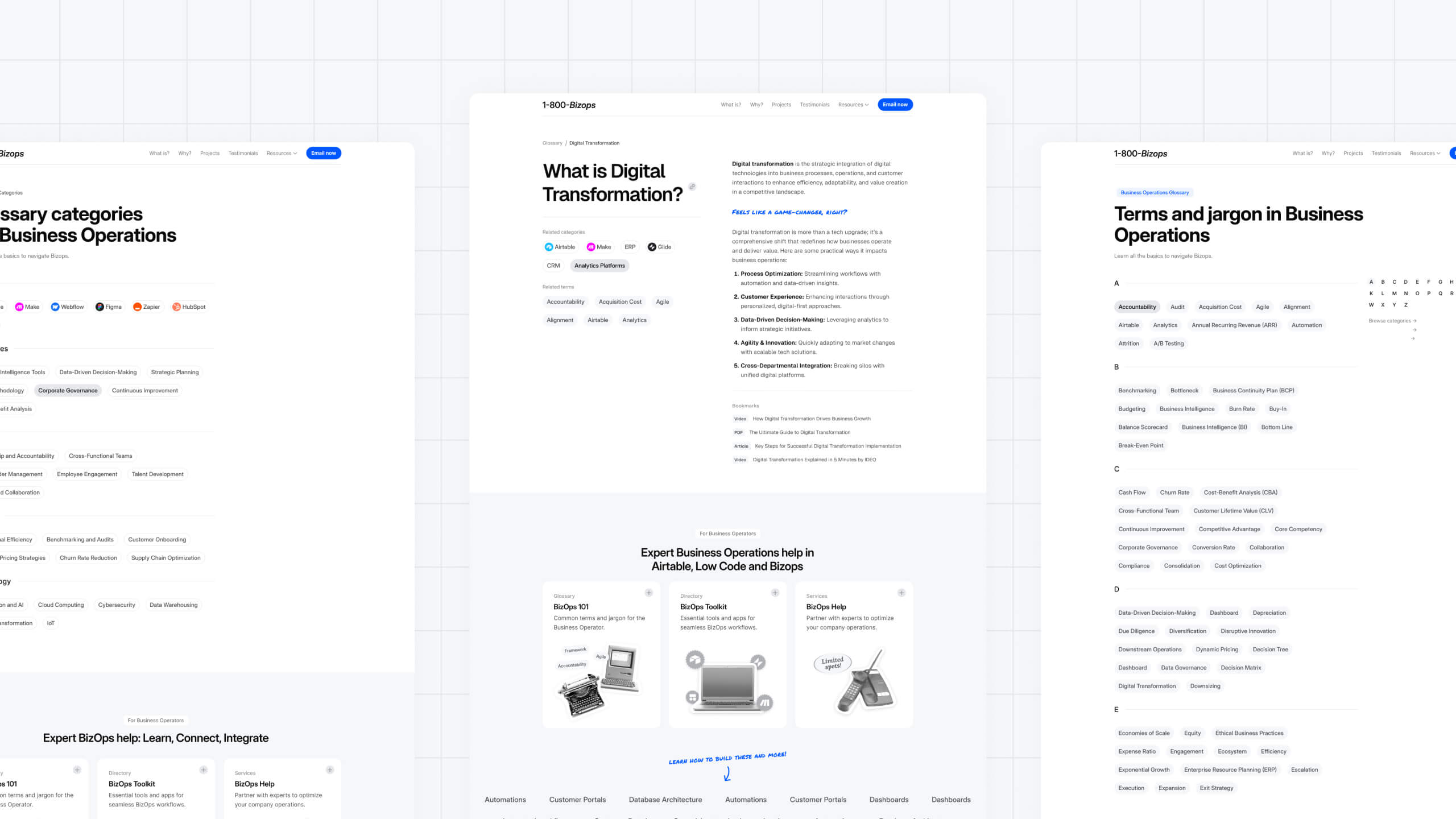Finally… Publish. Big relief. The new homepage for 1-800-Bizops is live.
A few months back I decided to double down on the services I had been providing for the last couple of years. As a contractor, consultant, freelancer, even as an employee. Come to think of it, I’ve been working in Operations (design, engineering, management…) for the better part of the last decade.
I decided on “1-800-Bizops” as a name. Yes. Simple, to the point. In essence it’s Bizops help, I thought. The very nature of the problem this service tackles is helping organizations design and build better business operations. First step: getting the name right. A name ample enough that stands the test of time and any potential pivots but niche enough to make all social media marketing influencers feel proud. Checkmark! Beautiful. This new homepage will finally ease the ranty feeling I get when trying to explain what we’re about in 1-800-Bizops to fellow business owners, organizations directors, and esteemed intrapreneurs.
Time to share. Let’s start with close friends. I copy the link, go to my oldest Whatsapp group, paste it and hit send. Then, the dreaded wait… First response: What is Bizops?
Oh boy.
Why we decided to build a Glossary
Bizops is one of those terms that gets a radically different meaning with context. Like “Project Manager”. You know what I mean? What’s the role of a PM? A conversation that has surfaced in close circles often lately. Well, it depends. Are you a PM for your family house remodel? Or are you a PM for Nasa’s next moon mission? Bizops is the same. Bizops people, in essence, integrate. They connect people, process, and technology to make an operation run better. But one Bizops’s role can differ to the next one by miles, depending on the industry, the area, and the organization they’re a part of.
So, the only way to explain what Bizops is, in the specific context of what we do, is by using our own definition(s). That’s how we decided to build a Glossary. One that defined our very own type of Bizops, the one we are experts in and ecstatic when able to partner with standout teams to tackle with together: digital operations with Airtable and Low Code apps.
Besides. This tool could also turn into a perfect example to show clients what we do, checking off not only the branding problem, but also becoming a cool marketing, pSEO, and domain authority engine.
So we dived in.
Step 1: Designing the Product
Like we do with our client work, we treated this initiative as a product. This meant starting with the user experience in mind. And in this case we had two of them: one navigating the glossary and the other one producing the content. The design process could be a whole post by itself, so I’ll try to keep it brief by covering the broad insights that shaped the product.
Some questions that helped define what we were building:
- In the era of AI, what would make this content and tool relevant and genuinely helpful?
- How do we make sure this glossary is checking more than a few boxes: helping with brand, pSEO, domain authority, and more.
- How can we pass along some of our real industry experience?
So this is what we landed on:
- Speak plainly. Clear explanations like you would get from a friend.
- Include context. So readers could understand when and why a concept matters.
- Keep it simple and fun. So people can find what they need without friction and enjoy of that sense of wonder internet products are great at surfacing.
We wanted our Glossary to look and feel simple and elegant. True to our brand and the work we do, which is always meant to be future-proof and scalable.
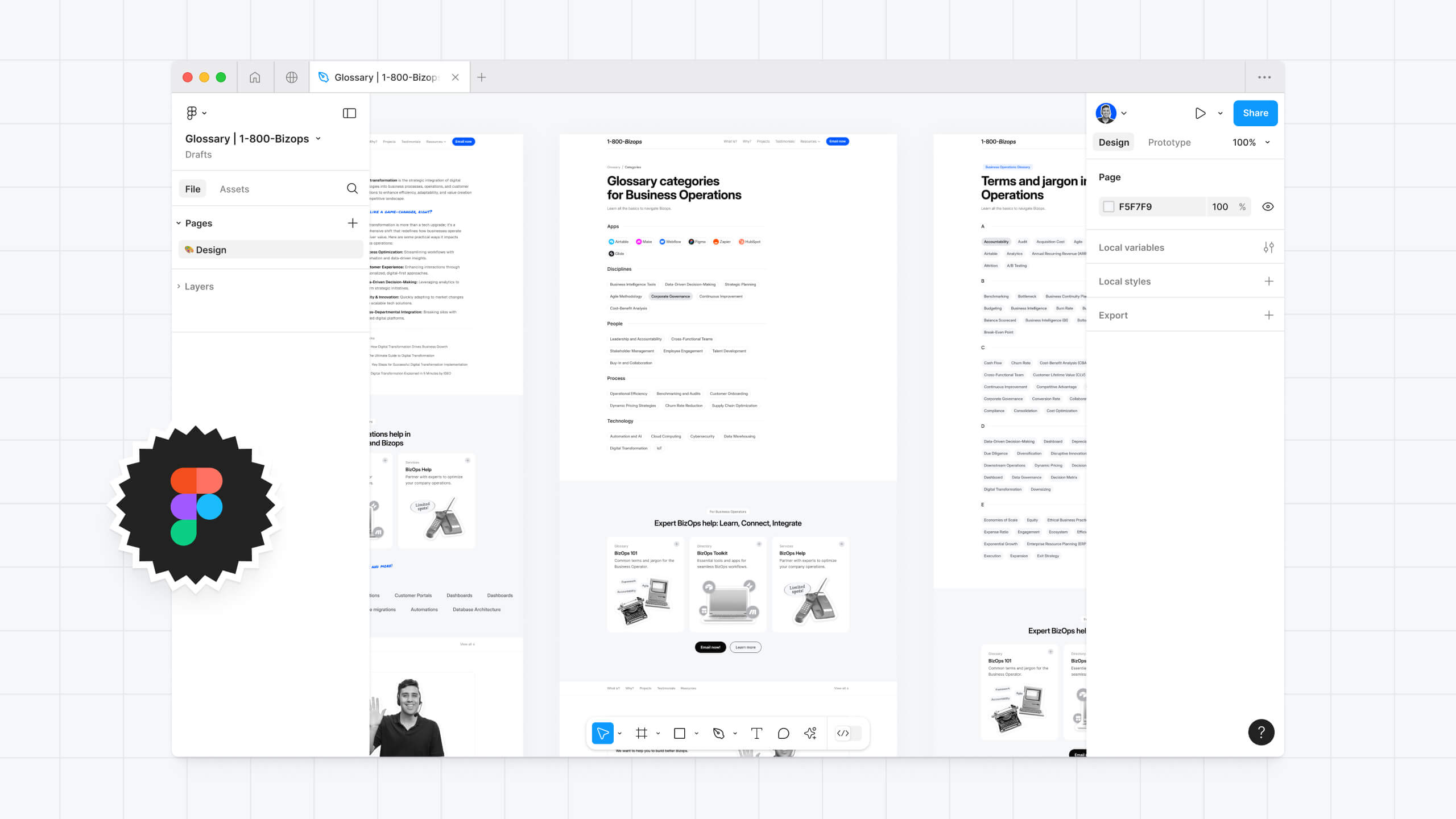
Step 2: Using Airtable as our content engine
With the goal of making this product feel personal in mind, we knew that dropping an existing list of digital operations terms as a starting point wouldn’t cut it. We had to come up with those that encompassed our own definition of Bizops. What are all those things we have had to learn through the years as we’ve navigated Bizops? Technical concepts that have enabled us to build in a scalable way? Frameworks that have shaped our ideas into successful digital products? Stakeholders we’ve had to serve one way or another and their involvement as we’ve navigated change in organizations?
So, we brainstormed and started thinking about the ways our users could discover them. Clicking through them not only by the term name itself but as a part of the area they are exploring at the moment, or the tool they are looking to understand better even.
This labeling strategy was later turned into a beautiful megamenu that helps users filter specific disciplines, Bizops areas, or tools, depending on what they are looking for.
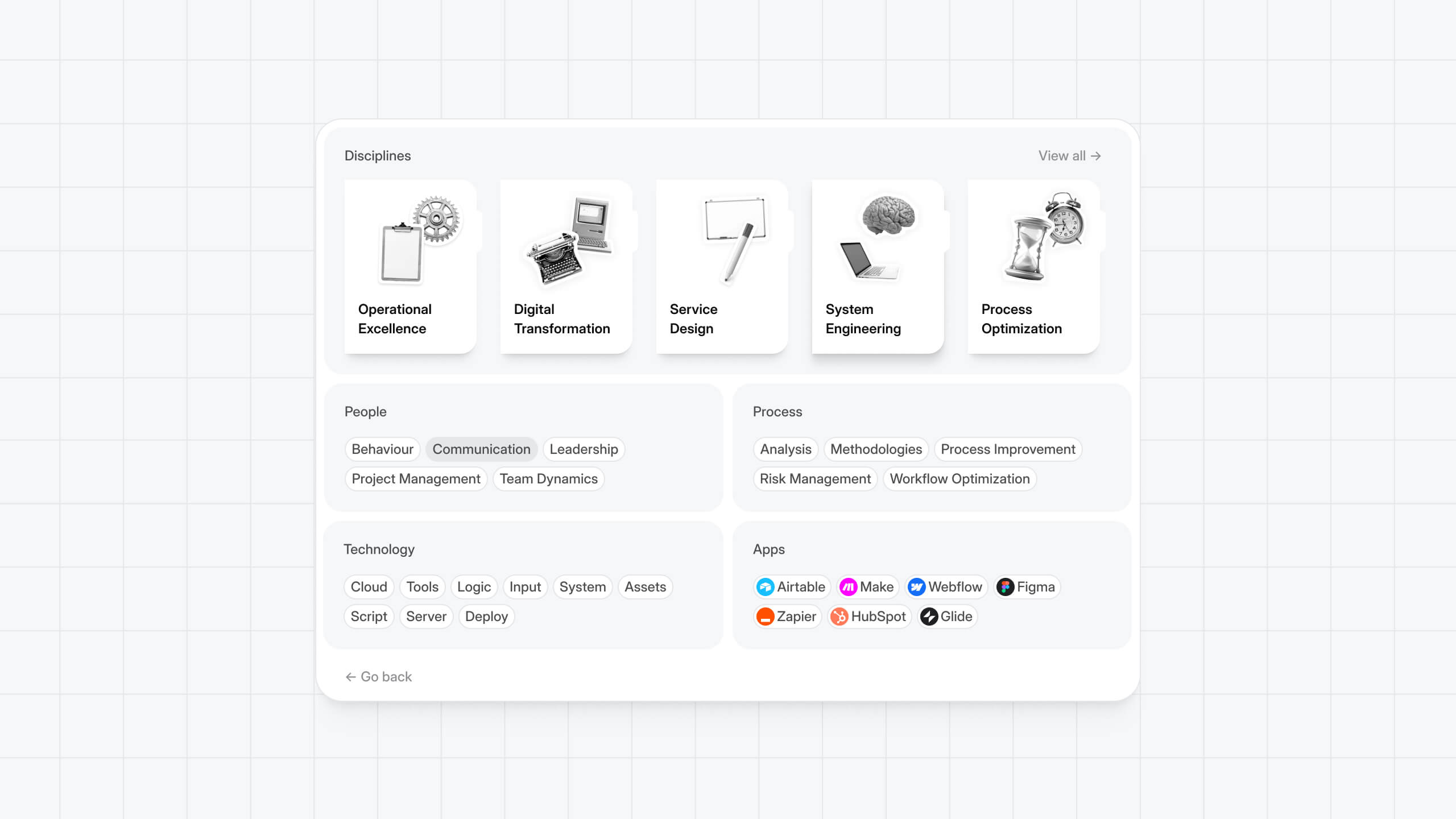
Step 3: Prompting AI + manually refining all content
Using Airtable AI’s capabilities, we were able to create robust prompts that helped us output sample definitions of each of our terms. But here’s the catch: these definitions were already context aware, they depended on the labeling the term was a part of, and by feeding them with our tone, they were already halfways produced in our language. This AI lift is what turned this project into a few weeks endeavor instead of a many months one.
With a structure in place for each term, it was time to start the real labor of love. We went on to manually edit definitions, add insights, correct analogies, share our favorite resources, and more.
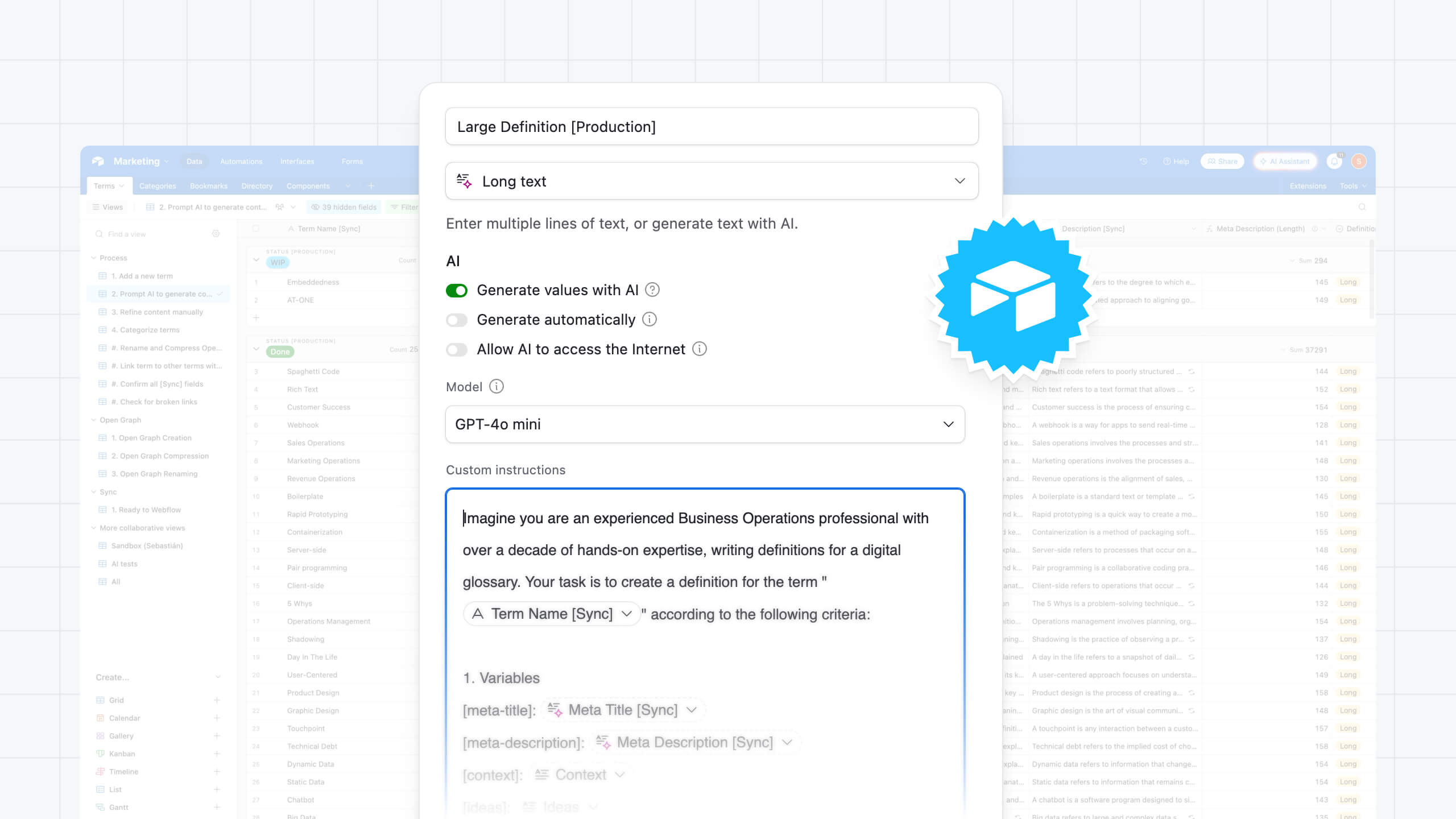
Step 4: Linking terms to other terms
Aside from the disciplines, areas, and tools a term belongs to, we thought it would be incredible if we were able to solve for term-to-term linking. Being a part of the same space, it was only natural that most of the terms mentioned other terms as a part of their definition, so we thought providing an easy way to reference them for easier navigation would be a value add.
Using Airtable, we came up with a novel AI process that allowed us to:
- Consume all existing terms.
- Look for them in a specific term description.
- Surface the ones found, or any similar ones (example: maybe “user interface” was not explicitly mentioned, but “UI Design” was.
- Provide a space for us to weed out errors manually, and select the relevant terms we wanted to link to in that description.
This was possible thanks to a clean CMS architecture made in Webflow and a simple Slug strategy set for all terms and their categories from the start.
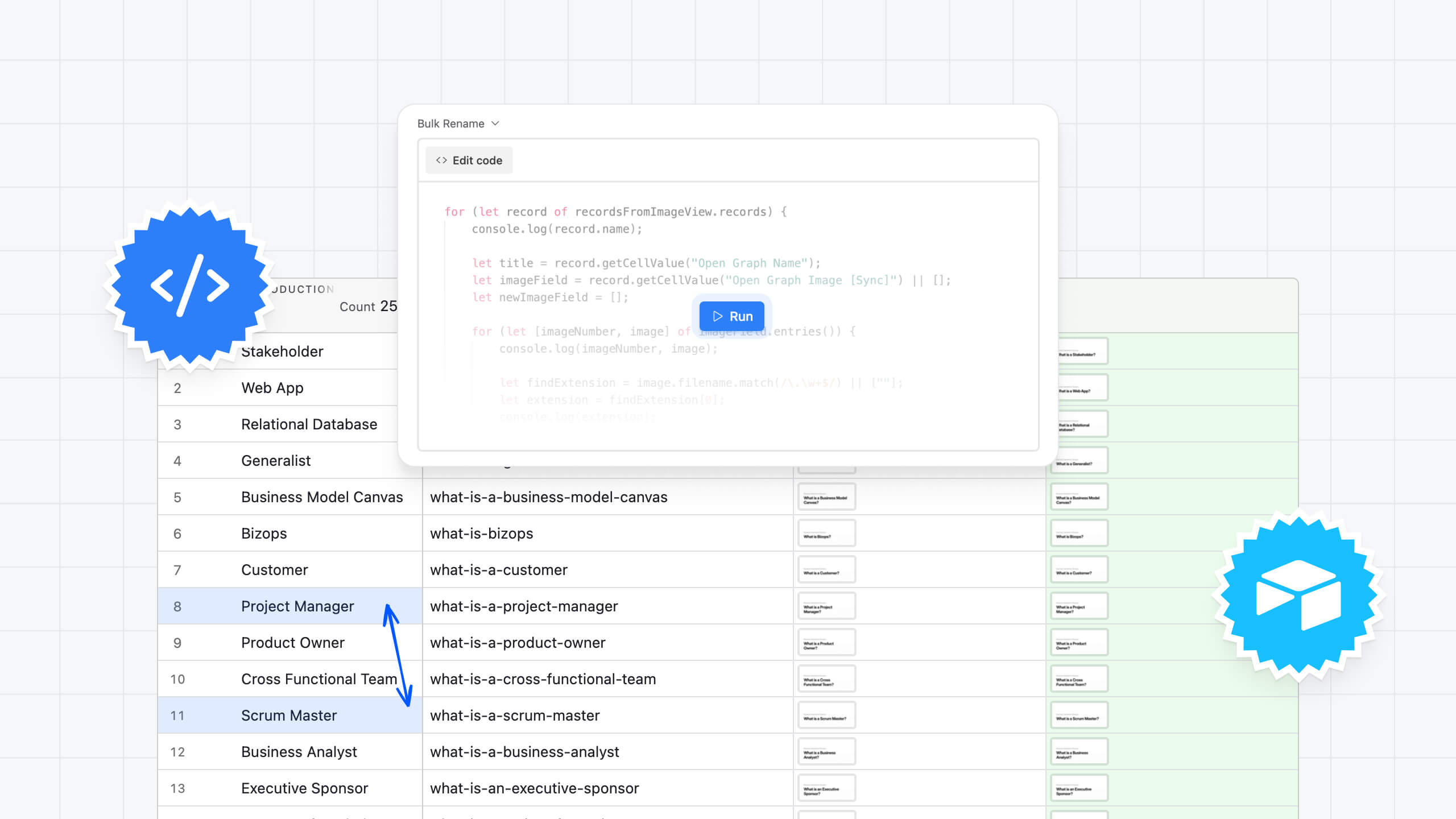
Step 5: Syncing Airtable with Webflow + Whalesync
With Airtable set up, we turned our attention to Webflow. With the pages already developed and the CMS architecture correctly set up, there was only one piece left: sending all the data to our front-end, our website in Webflow.
Fortunately, we had thought about this solution from the start: Whalesync. Using their robust platform we were able to set a seamless one-way sync between our Airtable base and our Webflow site, keeping everything as it was intentionally designed: separate tables, linked records, and even making use of uncommon Airtable fields like attachments and rich text. It was this architecture and sync that allows the product to be extremely interconnected, and empowers users to navigate between categories and related terms. And on the backend, it is what allows our team to create new terms, link them easily, and keep scaling this product as needed.
All in all, here’s a list of characteristics this product includes:
- 3 CMS collections: Terms, Term Categories, and Bookmarks
- A javascript custom-coded alphabet picker to navigate the glossary index page
- A megamenu that displays the distinct term categories
- 200+ terms with their description, applications, and even a personal remark from the 1-800-Bizops team
- Custom Open Graph images per term, to each its own (also created dynamicaly via Airtable)
- A sticky sidebar that shows related terms and categories for each definition
- A script that runs through all term slugs once live and confirms there are no broken links inside the page (good SEO practice)
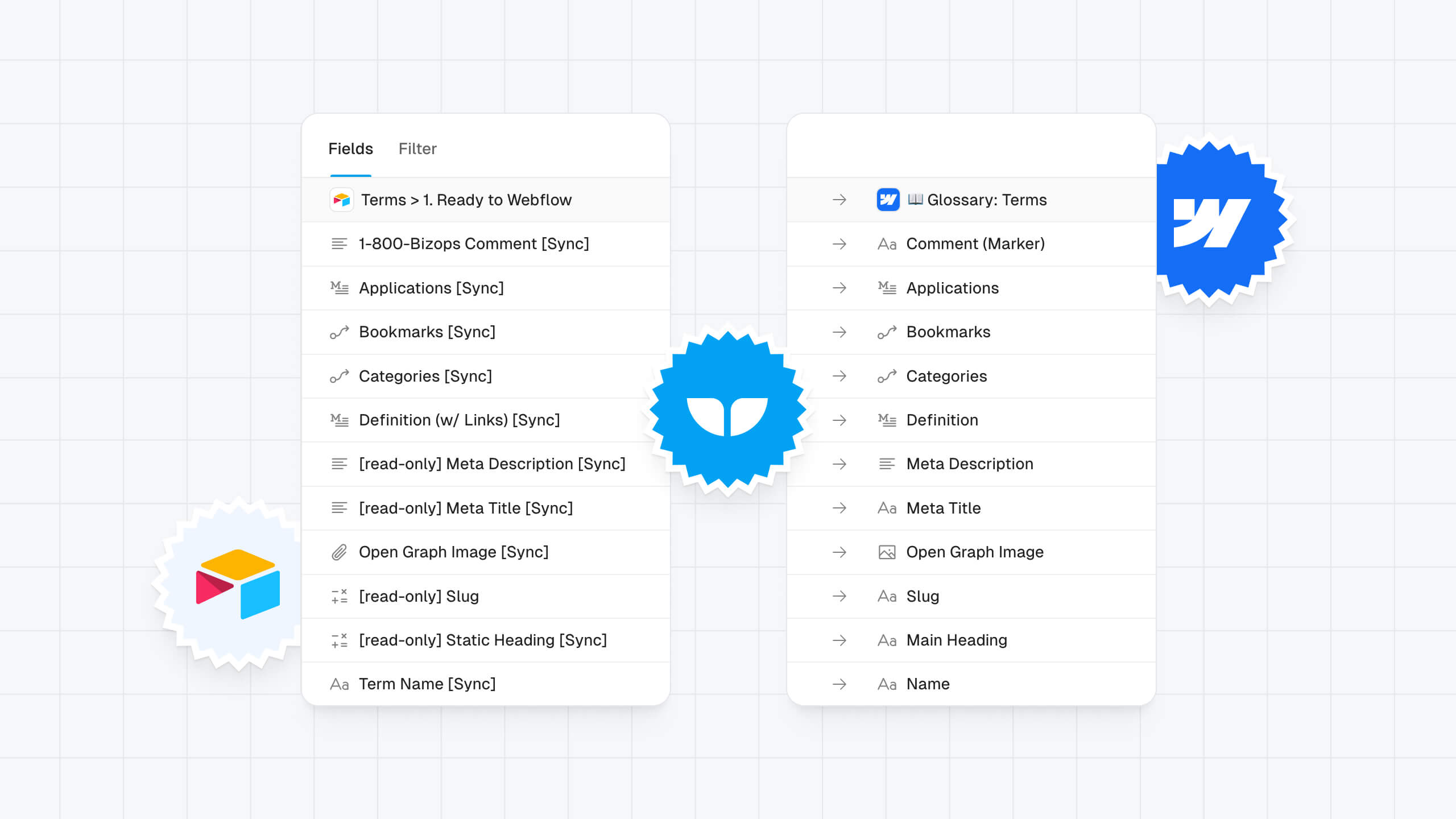
Now, ask us what is Bizops, please!
Once everything was in place, we set our dynamic Bizops glossary live. Every definition is rich, styled, and searchable. And updates are as easy as editing a cell in Airtable.
There is no manual copy/paste. No more spaghetti syncs. Just a smooth-running, scalable system.
Our glossary is a beautiful front-end in Webflow, powered with a clean relational database in Airtable, kept in sync magically with Whalesync. All of these tools, we already loved and used, so there were no additional costs. But we do now have a very significant upside…
Now, whenever someone asks, “Bizops? What’s that?” I just send them the glossary. And there are no more blank stares, no more explaining without tangibles. Just our very own take on Bizops communicated with a nice glossary we’re now proud to share with all of you.
